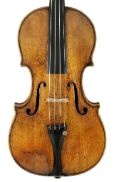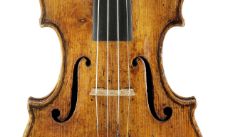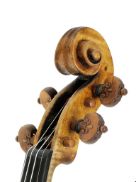Violin, Antonio Stradivari, Cremona, 1716, “ex Baron Oppenheim”
Printed label: “Antonius Stradiuarius Cremonensis / Faciebat Anno 1716” (716 handwritten)The violin named after banker Baron Oppenheim has an original label naming 1716 as the year it was built. Stradivari was already over 70 years old at the time, but his productivity remained in full swing. As the Hill brothers wrote, “Stradivari’s powers of production seem to become more marked as his years roll on; his energy apparently inexhaustible, and his fertility equally unfailing. More instruments belonging to this decade than to any other period of his life are known to us, amongst them the majority of his most noble existing works.” The 1716 violin is built on a large, wide pattern, possibly the inner mold lettered “PG” from the Museo del Violino in Cremona (inventory no. MS 21). Its two-piece belly has particular features that can also be found in other instruments Stradivari made during his late period. Below the foot of the bridge on the treble side and above the f-hole on the bass side, the wood has slight growth anomalies that Stradivari took in stride. The two halves of the belly are not from the same log and are dated 1707. The back is divided and shows regular, tight flames that descend slightly toward the outside. By contrast, the flames are wider on the ribs, pegbox and scroll. The upper eyes of the f-holes are wide apart, letting the chest of the instrument appear very broad. The cut of the f-holes and the relatively wide edges already foreshadow the work of Stradivari’s late period. The scroll is carved very regularly and has a powerful appearance. As is common on Stradivari instruments, the color varnish lies over a golden-yellow ground.
The list of owners of the “ex Baron Oppenheim” Stradivari goes all the way back to Luigi Tarisio. Starting in 1827, Tarisio, a violin dealer and collector from Novara in Italy, brought a large stock of valuable Italian string instruments – among them this violin – to France, where Jean-Baptiste Vuillaume became his most important customer. No records show who purchased the Stradivari from Vuillaume, but around 1890, it was supposedly played by a violinist who had studied with Joseph Joachim. Thereafter, it passed into the hands of the Oppenheim family. Purportedly, a baroness from this family of bankers gifted the instrument to violinist Gustav Exner of Berlin, also a student of Joseph Joachim’s. Exner was a member of the famous Halíř Quartet. In 1927, the violin made its way to the USA via Emil Herrmann. Tsugio Tokunaga, the first concertmaster of the Tokyo Symphony Orchestra, played the Stradivari from 1984 to 1993.






